May in Vancouver brings us warmer temperatures, an even greater diversity of plants in flower and considerably more activity from pollinators. Because of this floral profusion, I find that I’m slowing down even more on my daily neighbourhood walks. There isn’t much to celebrate about in these isolating times, but the new sights and fragrances of spring’s bounty is at least a cheerful reminder of the beauty that is all around us.
Many of the plants featured in April 2020 in the Neighbourhood are still in bloom. Check them out here.
Plants in bloom are featured in reverse order. Scroll to the bottom for the first week of May’s plants in bloom.
Updated May 25, 2020
Ceanothus ‘Victoria’ (Victoria California lilac)
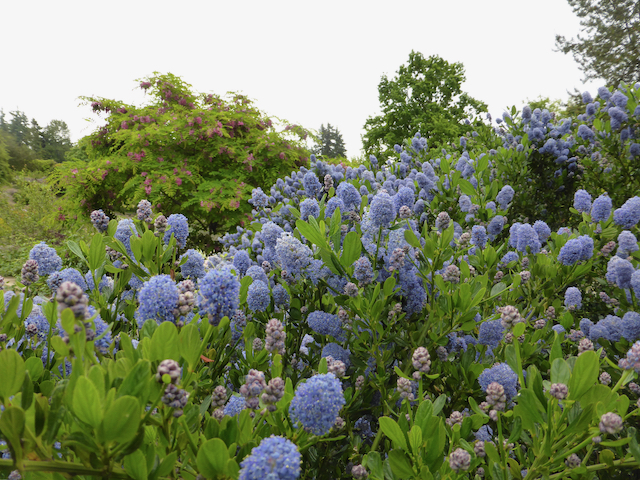
Ceanothus ‘Victoria’

Ceanothus ‘Victoria’
Ceanothus ‘Victoria’ (Victoria California lilac, blueblossom). Ceanothus is a genus of fifty or sixty species of shrubs and small trees native to North America. Two deciduous species are native to British Columbia, but both are plants of the mountains and are not generally cultivated in gardens. All Ceanothus species have nodule-forming, nitrogen-fixing bacteria associated with their roots. The same bacteria (Frankia alni) is associated with alders (Alnus species) and oleasters (Elaeagnus species). In much the same way as pea-family plants associate with Rhizobium bacteria, Frankia bacteria feed on the sugars (a product of photosynthesis) produced by the host plant, but “in return,” capture atmospheric nitrogen and convert it into a plant-available form (nitrogen is the plant nutrient required in the greatest amount by plants). The association allows these plants to exploit impoverished soils. Ceanothus are also valued for tolerating alkaline soils, for being moderately tolerant of salt spray and for their unpalatability to deer. The leaves of evergreen ceanothus are usually leathery and small, often noticeably veined or conspicuously puckered. The blue-flowered types are often known as California lilac or sometimes, blueblossom.
Few evergreen ceanothus are as reliably garden worthy in Vancouver, and C. ‘Victoria’ is consistently rated as the best of its kind. Because of its drought, salt spray and sun tolerance, as well as its ability to thrive in infertile ground, ‘Victoria’ is a popular choice for seaside plantings. The leaves of C. ‘Victoria’ are oval in shape, 0.5 to 2 cm long by about 1 cm wide, dark, glossy green with veins impressed above and prominent below. They are arranged along finely-ridged, green, then brown, well-branched, shoots. When plants are sited in full sun, leaf posture is often more or less vertical, and both the upper and lower parts of the leaves are visible. The small flowers are an exceptional azure blue, borne in congested clusters to about 7.5 cm long, at the tips of the new growth in late May or June. Plants are large, wide-spreading, and densely branched, growing 3 m tall by 4 or 5 m across.
Cornus kousa (kousa dogwood)

Cornus kousa ‘Milky Way’

Cornus kousa
Cornus kousa (kousa dogwood, Korean dogwood, Chinese dogwood, Japanese dogwood or strawberry tree). Whereas most other tree-dogwood species generally form single trunks, the habit of C. kousa is more shrub-like, at least for the initial few years, and trees are naturally multi-stemmed or low-branched. They eventually become broadly rounded. In general, trees will reach 7 to 10 m in height by 6 to 8 m wide within 15 to 45 years. Unfortunately, most trees are generally planted too close to buildings, roadways and services, given their ultimate size and spread.
The typical Cornus kousa produces its floral bracts after leaf emergence. Each flower cluster is surrounded by a group of four pointed bracts, initially green, but these gradually become white as they expand. In shape and size, they are much like that of a fully expanded leaf. Bracts often remain showy for six weeks or more, depending on temperature and shade. The tips of the bracts, and sometimes the entire structure, becomes ruddy with age and sun exposure. The fruits are initially green but turn red and expand to about the size of strawberries by midsummer. Isolated trees in areas where pollinator numbers are low typically produce much less fruit. The fruits can remain for some months, or until they soften sufficiently for the tastes of thrushes and similar birds. When ripe, they are edible for people too, but opinions vary as to taste and descriptions range from “pleasant” and “interesting” to “I’d have to be really hungry to eat that.” Unless plants are shaded, autumn colour is reliably good—orange to dark red. The trunk and larger limbs and their subtly flaking bark become more visible once leaves have dropped. The name kousa is evidently an English mispronunciation of the southern Japanese island of Kyushu, from which the first specimens known to western scientists were derived.
Lavandula pedunculata (Spanish lavender)
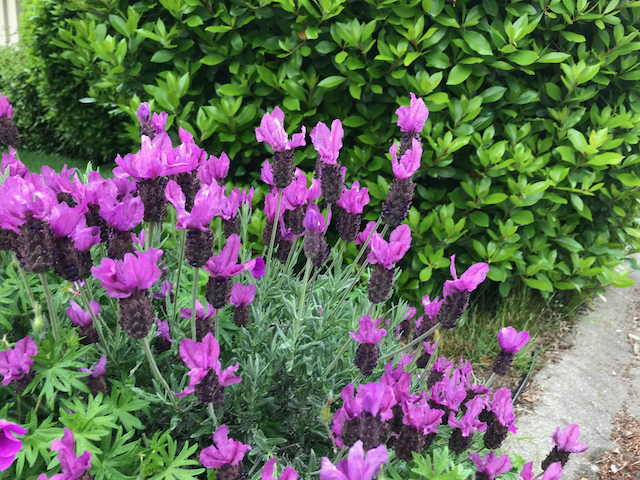
Lavandula pedunculata
Lavandula pedunculata (Spanish lavender, butterfly lavender). Most of the cultivated lavenders are woody-based “subshrubs,” and two or three species and a few hybrids are cultivated locally. Lavenders are famously tolerant of heat and drought and rocky, infertile, alkaline or acid pH soils, but they are also notoriously intolerant of shade, interference by other plants or structures, high humidity and poorly drained soils. The hardiest forms of Spanish lavender originate in the mountains of Spain and Portugal, where they grow on alkaline sandy soils.
The species has fine-textured, tufted, grey leaves, 2 to 4 cm long, on long, slender, ascending stems that can grow 50 to 80 cm high—though, they are usually smaller in cultivation. Flower clusters are more or less cylindrical and compact, 2 to 4 cm long by 1 to 1.5 cm in diameter, with comparatively large, mauve-green, conspicuously-overlapping bracts. The bracts almost completely obscure the tiny dark violet-purple flowers peeking out from in between them. However, Spanish lavender also bears large, mauve-violet, strap-like to spoon-shaped bracts that crown the club-like flower clusters, and these make the species instantly recognizable (and are the origin of the name “butterfly lavender”). Once the flowers are fertilized, the bracts enclosing the flowers turn brown and shrink back, exposing the tightly packed cylinder of developing green, eventually straw-coloured seed capsules. The aroma of L. pedunculata is sharper than that of the common lavender (L. angustifolia), with hints of bitter sagebrush or oregano adding to the familiar sweet lavender scent.
Papaver orientalis (oriental poppy)
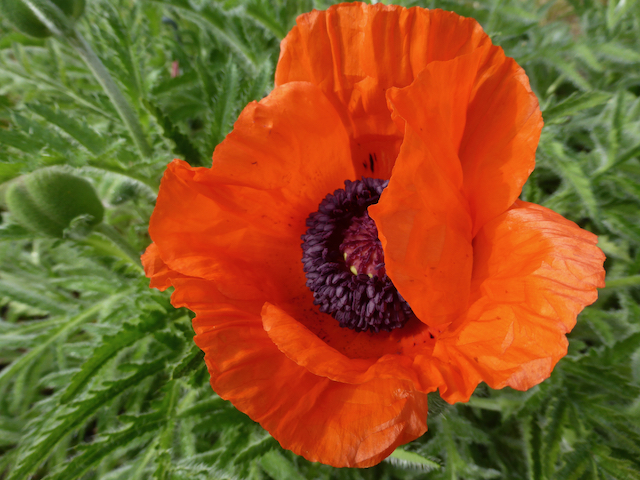
Papaver orientale

Papaver orientale
Papaver orientalis (oriental poppy). The poppy family (no, not the 1970s Canadian psychedelic pop group) is recognized by its brittle, succulent stems and medium to large, showy flowers. The species are either annuals (emerging, flowering, setting seed and dying in a single season), biennials (flowering, setting seed and dying in the second year, after a winter dormant period), or perennials (surviving multiple years). Most local people probably associate poppies with the red-flowered field poppies (Papaver rhoeas) of Remembrance Day significance. These are annuals, whose seeds are so tiny they lack enough stored food to power germination without sunlight. In Flanders (Belgium) after the end of the First World War, thousands of graves were dug for the fallen soldiers. The newly dug soil was full of field poppy seeds that had been lying dormant for decades. Once the soil was exposed to the sun, the poppies germinated and grew by the million beside the graves.
Oriental poppy also has tiny seeds, but it is a mounding, perennial species, with a permanent fleshy crown that lies just below the soil surface. In spring, multiple bright green stems emerge, each with a set of deeply-lobed, hairy leaves. Fat flower buds sit atop the stems and these gradually shed their sepals (there are only two) and then quickly expand four to six huge, vividly-coloured petals (usually pink, orange or red), each with dark blotch at the base. At first, the expanded petals look as though they were crumpled in the bud. In fact, they were. This unusual form of flower bud packing is known technically as “crumpled aestivation,” and is common to poppies and a few other groups of plants. Once fully expanded, the petals are smooth, with a characteristic silky sheen. Flowering continues through June, more or less, and fertilized flowers produce an attractive, flat-topped seed capsule. Soon after seeds are ripe, the foliage and stems die back completely, leaving only the capsule-topped flower stalks. The swaying of these stalks in the wind is sufficient to shake seeds out of the pores near the top of the capsule.
Robinia pseudoacacia (black locust)

Robinia pseudoacacia ‘Frisia’

Robinia
Robinia pseudoacacia (black locust). The genus is named for Jean Robin (1550-1629) and his nephew Vespasien Robin (1579-1662), herbalists to the French royal court. They introduced a number of eastern North American plants to Europe, including R. pseudoacacia. False acacia (the common name for Robinia) are generally known for their attractive, pinnately-compound leaves and often lavish, pendulous clusters of white or pink flowers. A number of Robinia species have sharp spines, at least on the young, vigorous growth. The paired spines can be large, and they afford the plants protection from herbivore feeding, but they also act as “extra-floral nectaries” (i.e., nectaries not associated with flowers). These provide sugary sap to foraging ants and parasitic wasps, which prevent the establishment of leaf-feeding insects and other pests.
Black locust is the largest and most widely distributed of the false acacias. From its original range in the mountains of southeastern North America, where trees are known to grow to more than 25 m tall, the species is now distributed throughout much of the milder parts of the United States and southern Canada. Black locust can be recognized by its craggy winter outline and deeply furrowed dark brown to nearly black bark (hence the common name). The deliciously fragrant flowers, which are generally only produced on mature plants in late May or June, are a characteristic pea-flower shape, about 2 cm long and pure white. They are borne in showy, hanging clusters of up to a few dozen flowers. While older R. pseudoacacia trees are a common sight around Vancouver, only the golden-yellow-leaved cultivar ‘Frisia’ is usually planted nowadays.
Updated May 19, 2020
Berberis thunbergii (Japanese barberry)

Berberis thunbergii ‘Atropurpurea’
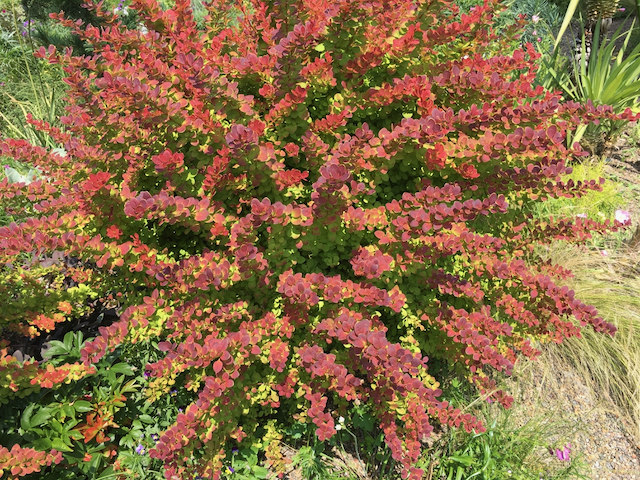
Berberis thunbergii ‘Tangelo’

Berberis thunbergii
Berberis thunbergii (Japanese barberry) is a spiny-stemmed, deciduous shrub to 2 or 3 m (6-10′) tall with rounded to spoon-shaped leaves. The stiff stems arch attractively, with secondary lateral branches arising in later years. The spines are typically short—almost unnoticeable—but still capable of catching a sweater or synthetic shirt when navigating through a planting. Flowers are produced in spring on short branches that are produced all along the shoots. The short branches are typically just a few millimetres long and each can be recognized by a three-pronged spine clustered together with a dense rosette of leaves. The flowers are bright golden yellow and bell-shaped, hanging in clusters of one to five.
The most common selections of Japanese barberry have deep purple leaves, and the yellow flowers make an eye-catching contrast with the darker foliage. Fertilized flowers are followed by bright red lozenge-shaped berries in summer or fall. Berberis thunbergii is highly invasive in eastern North America and has been reported as a garden escape in the BC Interior, but does not appear to be a problem here on the coast. From a gardening point of view, the species is notable for the variation in both its overall size and leaf colour. Foliage colour ranges in the various cultivars from chartreuse to deep velvety green, and orange through bronze to red and deep purple. Some plants are dwarf, only growing to around 50 cm (20″) tall.
The various combinations have led to dozens of cultivar selections. However, tests carried out by Agriculture Canada suggest that some cultivars may be susceptible to Puccinia graminis (black stem rust of wheat) a disease typically carried by the wild European barberry (B. vulgaris) across the prairies. As the stem rust is a “quarantinable pest,” federal plant protection regulations prohibit the importation and domestic movement of all species and cultivars of barberry (including hybrids and cultivars of the Japanese barberry), unless they have been demonstrated to be resistant to stem rust. And because “demonstration of resistance” requires extensive laboratory testing and Canada is a small market (the number of plants sold not worth the cost of testing), only a small selection of these attractive plants is available in Canada.
Dasiphora fruticosa (shrubby cinquefoil)

Dasiphora (Potentilla) fruticosa

Dasiphora fruticosa
Dasiphora fruticosa (shrubby cinquefoil). More commonly known under its former name Potentilla fruticosa, this deciduous shrub has a circumboreal distribution, inhabiting meadows, slopes and open woodlands across the colder parts of the Northern Hemisphere, including in alpine areas on our local mountains. Plants grow as low, rounded bushes, usually less than 1 m (3′) in height, although some selections can be somewhat taller in cultivation. Small, five-foliate leaves emerge from minute, nearly hidden overwintering buds in spring (common name cinquefoil, which is French for “five-leaf” derives from this).
As many of the leaves are retained in a withered and decomposing state as plants enter dormancy in autumn, the stems of shrubby cinquefoil can look pretty grubby. This behaviour of not dropping leaves is especially common in a humid, shaded environment, and these conditions also seem to encourage soft, floppy growth. In fact, Dasiphora can look like a discarded heap of rotting twigs over the winter in Vancouver. This is one of the reasons they are no longer much grown locally. However, the floral power of shrubby cinquefoil is seldom matched by other garden shrubs. The flowers are mostly yellow or white (rarely pink or orange), the five rounded petals surrounding a small boss of yellow stamens. They are borne profusely, in small, friendly-looking clusters towards the tips of the current season’s growth. Flowering often continues unabated from June into October, or until the first frost.
Paulownia tomentosa (princess tree)

Flowers of Paulownia tomentosa in cultivation

Paulownia tomentosa
Paulownia tomentosa (princess tree, empress tree, foxglove tree) is recognized as one of the fastest-growing, cold-hardy deciduous trees in cultivation. The species is originally native to central and western China, but it has been distributed to many temperate parts of the world, both as a timber species and an ornamental, and it has also escaped cultivation in a number of areas. One’s first impression of Paulownia is often of its ample, softly hairy (tomentosa = “softly hairy”), palmately-lobed leaves. In winter, the loose conical clusters of light brown flower buds at the tips of the naked branches are also distinctive. The flower buds, which are formed in the summer of the previous year, are remarkably cold-hardy, covered in their fine wool. Emerging from 10- to 30-cm (4-12″) tall, open clusters, usually around Mother’s Day, the nodding, foxglove-like flowers open all at once. The individual flowers are tubular, about 4 to 6 cm (1½-2½”) long. They are generally light purple-blue or lilac-purple outside and lighter inside often with nectar guides consisting of soft yellow stripes and purple spotting.
The flowers attract a variety of pollen- and nectar-feeding insects, as well as local hummingbirds. They are delightfully fragrant, and, unlike those of the true foxglove, which are deadly poisonous, these flowers are edible. They are apparently delicious, as well. Flowering may last for up to two weeks on the tree, especially if the weather remains cool. Plants in flower are exceedingly attractive. Vegetative growth starts within a couple of weeks of flowering, and on the vigorous young shoots the leaves are epic in proportion—up to 60 or 80 cm (24-30″) or sometimes even larger across, with major leaf veins on the leaf-back the thickness of a pencil. The new shoots themselves are conspicuously hairy and can be up to 5 or 6 cm (2-2½”) in diameter, with an annual growth increment of an astonishing 2 to 3 m (6-10′). With age, leaf and shoot size decreases, and growth rate slows. The wood of the Princess tree is highly prized for its workability when freshly cut, and its hardness and resilience when dry. It is variously used for a cabinetry and the manufacture of musical instruments, surfboards and dowry boxes, and in Japan for making traditional clogs. Both the common and scientific names commemorate the Princess (later Queen) Anna Pavlovna of the Netherlands (1795–1865), daughter of Tsar Paul I of Russia.
Viburnum plicatum (double-file viburnum)
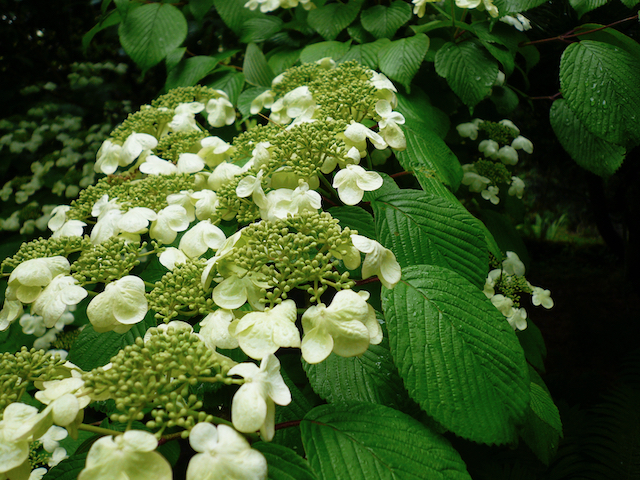
Viburnum plicatum
Viburnum plicatum (double-file viburnum) is a deciduous shrub native to China, Taiwan and Japan. Plants grow to about 4 metres (13′) tall and wide, with suckering shoots from around the base and with numerous spreading, horizontal branches. The flower clusters are generally large and the flowers white, produced well after leaf emergence. Nearly all of the flowers are tiny, arranged in flattened clusters, but there is a perimeter of larger showy flowers around each cluster – this is known as a lace-cap arrangement.
The leaves are oblong with coarsely saw-toothed margins, and when expanding in spring, have a pleated texture (plicata = pleated) from the deeply impressed, pinnate veins. Both the leaves and flower clusters are borne in pairs on either side of the long branches (hence, “double-file”). Locally, the most common selections of the doublefile viburnum include ‘Mariesii,’ a wide-spreading shrub noted for its opulent spring floral display and wine-purple autumn leaf colour, and the narrower, more upright ‘Summer Snowflake’, which produces a nearly continuous stream of smaller lace-cap flower clusters from May until frost.
Wisteria sinensis (Chinese wisteria)
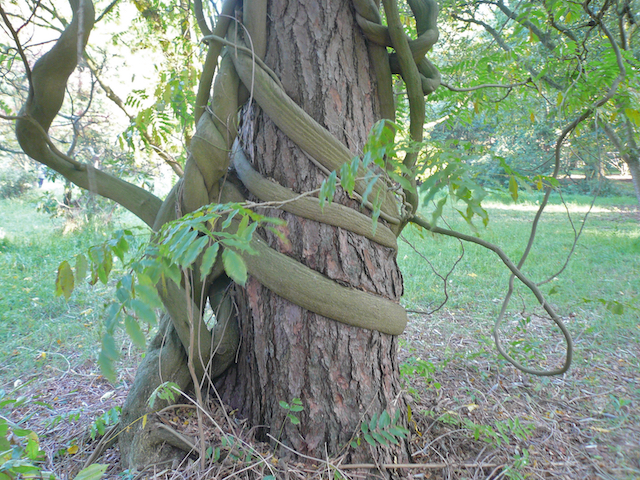
Wisteria sinensis on Pinus nigra

Wisteria sinensis
Wisteria sinensis (Chinese wisteria). Wisteria species have spirally-arranged leaves on vigorous, muscular, twining stems. The leaves are deciduous and pinnately-compound (i.e., with two flattened rows of leaflets along a central stalk). The flowers are typical for most legumes (pea family plants) – that is, they have a broad banner or “standard” petal above two lateral “wing” petals that flank a pair of narrow petals that are fused together at their base and form a “keel” that projects forward. The keel petals themselves enclose the stamens and carpel, which are held under tension until the weight of a pollinator (usually a bumblebee) releases them by standing just so on the keel. The release of the ripe stamens brushes pollen on the hairs on the underside of the bee, while the release of the carpel with its pollen-receptive stigma collects pollen, presumably from a different bee that has visited other pollen-releasing flowers. The fruit is a legume and both the legume and seeds are poisonous. Ingested seeds are reported to cause hallucinations, along with more serious and lengthy medical complications. Definitely don’t try this at home.
Chinese wisteria is an exceptionally vigorous climber, capable of smothering buildings and ascending tall trees. The species can grow to 25 m (80′) or more on a suitable host. Stems twine leftward (anti-clockwise) around any object less than about a meter (3′) in diameter. The leaves have seven to thirteen leaflets, and the long-stalked flowers are borne on densely-flowered, 15- to 30-cm (6-12″) -long (or longer) stems. The flowers are lilac-blue to white and open more or less simultaneously on the flower stem just prior to leaf emergence. They are deliciously fragrant.
Updated May 11, 2020.
Clematis montana (mountain clematis, anemone clematis)

Clematis montana

Clematis montana
Clematis montana (mountain clematis, anemone clematis). Apart from Rosa (roses), Clematis is the largest genus of climbers in Temperate climates. Over two hundred species of Clematis are found worldwide, throughout Asia, Europe, North America, New Zealand and South Africa. Clematis flowers have no true petals (the petal-like structures are actually sepals) and the leaves, which occur in pairs at the nodes, are usually divided into three to fifteen leaflets. After flowering, heads composed of plumed “seeds” develop and remain on the plants, often into the winter.
While there are some non-climbing species, most Clematis plants support themselves by twining through shrubs and trees. The characteristic clematis grip is described by the twisting and wrapping of leaf and leaflet stems around other stems and stalks. Famously, clematis can only grip an object with a diameter smaller than about 13 mm (½”), which is why training clematis over a sturdy wooden trellis or up a tree often requires strings or wires or some other small-diameter scaffold on which the clematis can get started. Once the stems are fixed in place, new stems readily become attached by twining around the older stems. Clematis montana is a common species in residential neighbourhoods, as it is free flowering with attractive foliage and easily trained. Unconstrained, C. montana can grow 10 or 20 m (33-66′) up a suitable tree (conifers, such as western red cedar, are ideal hosts). The species is sometimes called the anemone clematis because of its resemblance to the flowers of that genus, but it also goes by the name mountain clematis (montana = of mountains—it is native to the Himalayas and the mountains of southwestern China).
The sweetly-scented flowers are produced from early May to early June from buds formed on the previous year’s wood. Flower colour ranges from white to deep rose pink, and flower size from 2.5 to 10 cm (1-4″) across, with four or occasionally more, usually broad sepals, and with stamens and ovaries forming a greenish-white to yellow centre.
Cytisus scoparius (scotch broom)

Cytisus scoparius

Cytisus scoparius

Cytisus scoparius
Cytisus scoparius (broom, Scots broom, or more commonly, scotch broom). Cytisus are generally known by the common name “broom” because of their long, straight, fibrous, but flexible shoots that are produced close together in sheaf-like bunches (scoparius means “broom-like”). It doesn’t take much imagination to see that a well-furnished branch could easily make a serviceable broom. Indeed, the term for the sweeping implement is evidently derived from these plants, and not the other way around.
An aggressive invader of dry, infertile, gravelly soils and waste areas, where it tends to create monocultures, Scots broom is no longer intentionally cultivated. It is nevertheless exceptionally common around Vancouver. Locals are likely familiar with C. scoparius, either because of its colourful flowers and surprisingly bright green spring shoots, or by the penetratingly musty fragrance of its flowers (some people aren’t bothered, but others can’t abide the smell).
Plants are typically narrow and tall, with abundant, slender, dark green, ridged stems and handsome, bright yellow to bicoloured, yellow and mahogany-red flowers. The flowers of C. scoparius are borne in moderate profusion and attract both honeybees and native bumblebees. The small leaves are a significant feature in the spring until after flowering, when, locally, they are shed. This time corresponds to our usual summer drought period. Seed production is considerable, and as broom seeds show a strong tendency to remain dormant for years, the “seed bank” below an established colony can be prodigious, and therefore problematic for decades. Scots broom is exceedingly difficult to control once established. It has deep, fibrous roots that are nearly impossible to dislodge from the soil once the plants are established. And it has the ability to re-sprout from the roots, if cut.
It’s difficult to find anything good to say about such a pernicious weed, but according to Modern Herbal published by Mary Grieve (1930), “before the introduction of hops, the tender… tops were often used to communicate a bitter flavour to beer, and to render it more intoxicating.” But don’t try this at home.
Sorbus aucuparia (European mountain ash, rowan)

Sorbus aucuparia

Sorbus aucuparia
Sorbus aucuparia (European mountain ash, rowan). Sorbus are members of the rose family, part of the group that includes Malus (apple), Pyrus (pear), and Cotoneaster among other familiar garden plants. Most have deciduous leaves and all have a fruit (a “pome”), which is fleshy inside but has an internal “core” surrounding the seeds. To everyone (except botanists), they are known as berries. Sorbus are valued ornamentally for these but also their pinnately-compound leaves. Large clusters of small, white flowers are produced early in the spring, set attractively against the bright green emerging foliage.
Unfortunately, the flowers have a particularly rank, dead-fish-and-ammonia smell. This aroma is produced by the aromatic compound trimethylamine, and the same compound is present in the flowers of pears, and to a lesser degree, apples and cotoneasters. This is an aroma that is as penetrating as it is repellent (unless you’re a pollinating fly). Luckily, the flowers only smell for a week and usually only at close range, so most people don’t notice. In medieval times in Europe, the presence of S. aucuparia outside a home was considered an indication that there were no witches living in the dwelling. As a consequence, mountain ash was often planted outside houses.
European mountain ash produces dullish orange to red berries that ripen in autumn, and the large clusters often weigh down the branches when ripe. The name aucuparia translates from the Latin as “bird catching,” and the fruits were apparently once used for that purpose. This is easy to see, as all manner of birds feed voraciously on the berries. In feeding, our winged friends distribute seeds in their droppings and the seeds germinate easily in local woodlands.
Choisya ternata (Mexican mock orange)

Choisya ternata
Choisya ternata (Mexican mock orange). Choisya are aromatic shrubs in the citrus family. The flowers look and smell strongly of orange blossom, and most Choisya species are from Mexico; hence, the common name, Mexican mock-orange. It should be noted that the vaguely orange blossom-smelling flowers of Philadelphus (a genus of unrelated deciduous shrubs) are also known as mock-orange. The name Choisya was published to honour the Swiss botanist, theologian and philosopher, Jacques Denis Choisy (1799-1859).
Choisya ternata is a distinctive broad-leaved evergreen shrub, noted for its lush, almost rubbery, trifoliate (three-parted) leaves and lax stems. The leaves are composed of usually three glossy, bright green, nearly overlapping, 3- to 7.5-cm (1.5 to 3.5″) -long leaflets (ternata means “in threes”). The developing leaves expand gradually, radiating around the shoot tip, overlapping symmetrically with older, successively larger sets of leaves radiating below. Individual flowers are about 3 cm (1¼”) across, and produced in multiple, rounded, 8- to 10-cm (3-4″) -wide clusters. They are attractive and exceptionally fragrant but can easily be overshadowed by the pungent aroma of the leaves and stems if the shrub is handled or rubbed against.
Malus (apples and crabapples)

Malus ‘Prairie Fire’

Malus ‘Prairie Fire’

Malus floribunda

Malus domestica
Malus (apples and crabapples). Malus is well known in horticulture, both for the culinary apple—of which there are a staggering 7,500 known cultivars—and the crabapples (or crabs), whose foliage, flowers and fruits are often remarkably ornamental. Apple flowers are usually pink in bud, opening white, the five petals detaching after fertilization. The five tiny green sepals persist—these are the small leafy appendages in the hollow at the base of an apple. The characteristic fruit (a pome) forms from the fertilized ovary, surrounded by and fusing with the remaining floral tissues (the ovary sits in a little cup) and the adjacent stem tissues at the base of the flower. Crabapples are no different in their development, except that their pomes are smaller and often more lozenge shaped. As ornamentals, crabs are sometimes compared with flowering cherries as residential-scale trees with multi-season features, but crabapples are often more disheveled looking, with typically bent trunks, twiggier, more congested crowns and brown to light brown bark that lifts untidily in small patches and plates. Nevertheless, crabapples are often renowned as highly suitable for the residential landscape. Many are of small stature with attractive foliage, flowers and fruits. The flowers come in a wide range of colours, including white, pink, red, rose and purple, and their leaves can be green, bronze, red or purple. The combination of flowers and emerging foliage can be spectacular. The fruits too are often exceedingly colourful, though in Vancouver, we rarely see them—either because they are hidden by foliage or they are quickly taken by birds. Like their culinary cousins, the apples, nearly all crabs require cross pollination, so without a compatible cultivar or seedling nearby, no fruit will be produced.
Unfortunately, all Malus are highly susceptible to leaf diseases such as scab and powdery mildew, and to stem cankers, as well. These diseases are all spread on the wind (by microscopic spores), so are exceedingly common when the conditions are right. This year and last, however, the crabapples have been glorious in Vancouver. This is most likely because of the relatively dry spring weather and warm conditions the preceding summer, when the trees set their flower buds. It is worth noting that crabapples are much more successful in Victoria and in Seattle, cities that have similar but marginally drier climates than Vancouver.

Malus ‘Dolgo’

Malus baccata

Malus ‘Spigold’

Malus ‘Vananda’
Updated May 4, 2020.
Aesculus hippocastanum (European horse chestnut)

Aesculus hippocastanum

Aesculus hippocastanum

Aesculus hippocastanum
Aesculus hippocastanum (European horse chestnut) is an impressive species, ultimately towering to nearly 40 m (130′) with a broad, rounded crown. The trees are handsomely endowed with stout branches and large, decidedly sticky buds, from which sizeable showy flowers and the huge leaves emerge in spring. The palmately-compound leaves, which are up to 40 or 50 cm (16-21″) across, are composed of five to seven paddle-shaped leaflets. Upright clusters of large, pink-streaked, white flowers in April or May are followed by clusters of 5- to 7-cm (2-3″) -diameter, soft-prickly fruits in summer. These leathery husks eventually fall and split open to expose one to three glossy brown, rounded seeds within.
The prickly fruits are superficially like those of edible chestnut (Castanea), but unlike the chestnut, are inedible. In fact, all parts of the tree are actually poisonous, even to horses. The name “horse” probably refers to the coarseness and large size of the tree. Whatever was Linnaeus’ original meaning, horse chestnut is the appropriate translation (hippo = horse + castanum = chestnut) for his Latin epithet. The glossy seeds of the horse chestnut have been used most famously for the children’s game known as “conkers,” which is also the name given to the huge seeds. Conkers are evidently an effective spider repellant.
Aesculus hippocastanum ‘Baumannii’ has double flowers that are even showier than those of the common horse chestnut. It is a fruitless cultivar but is otherwise indistinguishable from the species.
Aurinia saxatilis (Basket-of-gold)

Aurinia saxatilis
Aurinia saxatilis (basket-of-gold). This common rock-garden plant is native to central and southeastern Europe and Asia Minor, where it grows on rocky limestone slopes (the name saxatilis means “growing among rocks”). In Vancouver, plants are frequently seen atop south-facing walls, where there is unadulterated sunshine and perfect drainage. This suits the species perfectly, but plants also benefit from the extra calcium afforded by older concrete and mortared rock walls. Although typically classified as an herbaceous perennial, the species is technically a subshrub, with lower stems and roots that eventually become woody. Leaves are grey-green, minutely hairy, and somewhat spoon-shaped, appearing in loose rosettes. But basket-of-gold often goes unnoticed until it opens its flowers, which are brilliant lemon yellow and borne in frothy masses that cascade along the ground or down a slope. The flowers are individually very small, each with four tiny petals. They produce both to the pollen and nectar and are enormously popular with honeybees and other pollinators.
Cornus nuttallii (Pacific dogwood)

Cornus nuttallii
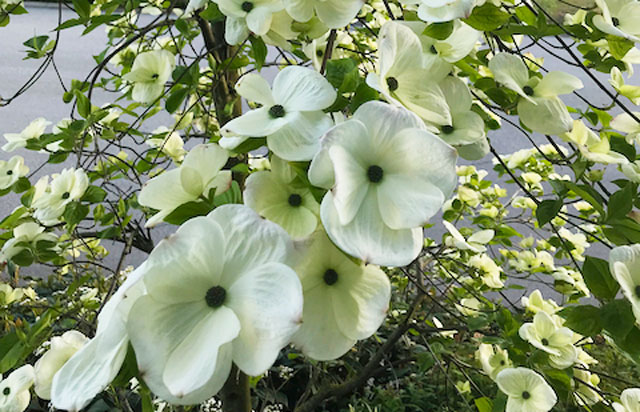
Cornus ‘Eddies White Wonder’

Cornus ‘Eddies White Wonder’
Cornus nuttallii (Pacific dogwood) Our native dogwood tree, the floral symbol of British Columbia, is a natural constituent of sunny forest edges, primarily in the southwestern corner of the province, and south into California. Pacific dogwood is a medium-sized tree, sometimes growing to 20 m (65′) in the wild. In cultivation around Vancouver, the tree often has an attractively layered pyramidal crown profile, and in the open, trees often maintain their lower branches to the ground. Flowers generally precede the leaves, and close inspection shows that the actual flowers are tiny and collected together in a button-like head. Surrounding the flowers is a set of whitish, leaflike appendages known as bracts. The species typically displays six bracts, and the whole arrangement of bracts and flowers can be more than 10 cm (4″) across.
Although first collected scientifically in 1826 by the Scottish botanist David Douglas, who mistakenly assumed it was the same as the eastern dogwood, C. florida, the English botanist and zoologist Thomas Nuttall recognized that it was different. Nuttall sent a description of this tree to his friend, the renowned ornithologist John James Audubon, because its fruits were particularly attractive to the band-tailed pigeon. Audubon later published a now-famous painting of the pigeon feeding on the dogwood fruits (see below) at the same time he published the scientific description of the dogwood. Note that the plant normally produces a second crop of flowers (and bracts) in early autumn, when the spring-produced fruits are ripe.
‘Eddies White Wonder’ dogwood (Vancouver’s centennial tree) is a hybrid of C. nuttallii and C. florida produced by Vancouver-area nurseryman Henry M. Eddie. It was evidently the only dogwood that survived the catastrophic flooding of his nursery in the famous Fraser River flood of 1948. The tree has very little of the character of eastern dogwood. Indeed, it is more like C. nuttallii, except that it is somewhat open and irregular in its branching (it is especially gawky when young), and has much larger and considerably longer-lasting, four-bracted, rather than six-bracted, flower clusters. Because of its ease of propagation and relative disease resistance, it is more common in cultivation than the native species.
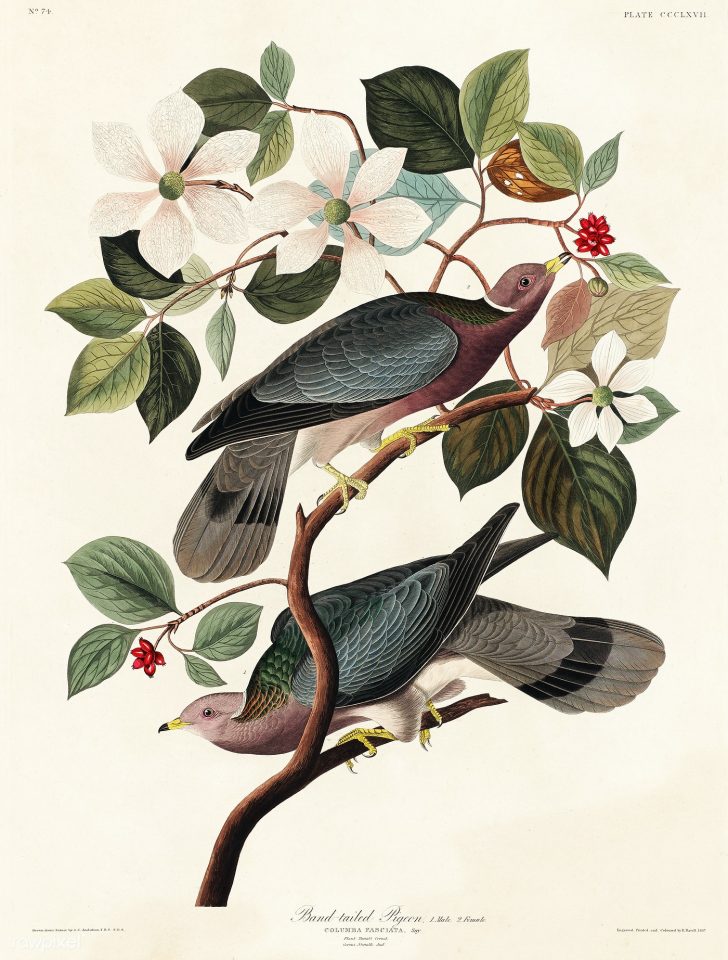
John Audubon’s painting of pigeon and dogwood
Hyacinthoides hispanica (Spanish bluebell)

Hyacinthoides hispanica

Hyacinthoides hispanica x non-scripta
Hyacinthoides hispanica (Spanish bluebell) is a bulbous plant native to Spain and Portugal and adjacent northern Africa that has escaped from gardens in various places in North America, including in the Vancouver area. The bulbs are white, about 5 cm (2″) in diameter and often found very deep in the soil. Plants appear in April, the shiny, strap-shaped leaves emerging at the same time as the flower stem. Like a dandelion or an onion, the Spanish bluebell flower stem has no leaves, and is called a scape. The scape looks a little like an asparagus spear before the flowers start expanding. There are usually between six and eight flowers per scape, and the individual flowers have six narrow tepals (there is no differentiation between sepals and petals in Hyacinthoides, so tepals). These tepals flare jauntily at their tips, much in the same way as the flowers of the true hyacinth (Hyacinthoides means “like a hyacinth”). Tepals are mostly light blue, but they can be pink or white. The flowers have no discernable fragrance. Plants with slightly darker, fragrant flowers that are borne on one-sided scapes with drooping tips may be the rarer H. non-scripta (common bluebell). There are hybrids between them, the flowers and scapes intermediate between the two parents. Depending on your point of view, Hyacinthoides are beautiful, naturalizing bulbs or aggressive weeds.
Syringa vulgaris (Common lilac)

Syringa vulgaris ‘Sensation’

Syringa vulgaris
Syringa vulgaris (common lilac) is native to rocky hillsides and mountain slopes on the Balkan Peninsula in southern Europe where it forms colonies. The common lilac grows 6 to 7 m (18-22′) tall in habitat, eventually becoming somewhat tree-like. Stems are smooth and grey at first, then develop fibrous bark. The dull, dark green papery leaves are heart shaped. Common lilac is generally grown for its mostly up-standing conical clusters of strongly fragrant flowers. In Vancouver, flowers are produced after leaf emergence, in late April or May. Depending on the cultivar, flowers can be white or lilac-pink to purple, picotee-edged or double, in clusters up to 18 cm (7″) long. Other than its unfortunate susceptibility to bacterial blight, which is frequently horribly disfiguring to the leaves, common lilac makes a handsome shrub or small tree and is otherwise well-suited to Vancouver’s climate. In the sun, plants flower well, but are typically stout-branched and compact, while shaded plants flower less well but have more elegant, slenderer upright branches. There are scores of cultivars available, in a range of colours. The name “syringa” is derived from the Greek syrinx, or “tube,” referring to the pithy, easily hollowed-out stems of some species. The common name, lilac, is from lilac or nilak, a Persian word meaning “bluish.”
Submitted by: Douglas Justice, Associate Director, Horticulture and Collections

We are happy you to hear that, thank you.
Glad you enjoyed!
Thank you, Susanna. We are glad to hear that you found this feature impactful.
I love these bulletins, learns lots, and look differently at the world around me after reading them. Thank you.
I was very interested to read the information about the Paulownia tormentors as I have a beautiful tall tree in the top corner of my garden. In North Vancouver. People walking by are amazed by the huge flowers which are now scattered all over my lawn after all the rain.
Great information. Now you need to educated your audience about all the other lilac Series and species, especially the early S. oblata and S. ×hyacinthiflora, the Pubescentes Series or Lilttleleaf Lilacs blooming right after the common lilac, and the Villosae Series or Late Lilacs blooming even later, ending with the Ligustrina Series or Tree lilacs. Planting cultivars from each group can prolong the flowering season to 8 weeks.
lovely thank you
love the depth of info. thank you.